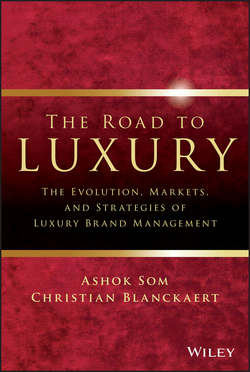Читать книгу The Road To Luxury - Blanckaert Christian - Страница 7
На сайте Литреса книга снята с продажи.
Chapter 1
Introduction
Definition and Crisis of Luxury
ОглавлениеLuxury has a long and fascinating history. It is apparent in artifacts from the Egyptian period of lavishness, from 1550 to 1070 b.c. Another great wave of luxurious lifestyle occurred during the Italian Renaissance, an era of great painters, sculptors, and architects during the fourteenth through sixteenth centuries a.d. This was followed by the reign of King Louis XIV of France (1638–1715), whose reign expressed an authentic French lifestyle. Then came Charles Frederick Worth (1825–1895) of Great Britain, a designer who created the concept of haute couture. Worth moved to Paris in 1846 to perfect and then commercialize his craft, holding the first fashion shows and launching the use of fashion labels. Coco Chanel (1883–1971) and Christian Dior (1905–1957) gave birth to modern fashions and ideals, marked by the rise of New York City as a luxury capital. The 1960s and 1970s then experienced the second Italian luxury revolution. Gucci and Bernard Arnault started applying the principles of strategic management to modern luxury by building the first multibrand conglomerate, Louis Vuitton Moët Hennessey (LVMH) group. The latest chapter to this fascinating tale of luxury and high fashion is the information technology revolution, in which news about a new product spreads like wildfire and opinions on brands, products, and companies are shared at the click of a button. The story of the evolution of luxury is really about the evolution of society.
Countries evolve through various phases of luxury consumption. The first stage is deprivation, in which a country is crushed by poverty, which builds in the populace the desire to consume. As soon as the country manages to free itself from the shackles of deprivation and witness economic progress, its citizens are lured into buying luxuries that have high functional utilities, like washing machines, cars, and practical appliances. Then the wealthy and elite start buying luxury products. The third stage of development is marked by the desire of citizens to show their wealth: Mere possession is insufficient when luxury goods become a symbol of social status and bestow their owners with an aura of divinity. Then comes a stage in which most people in the nation are well-off and have sufficient resources; however, they have a need to fit in with their group. If someone is not carrying or wearing an appropriate social marker, they might find it hard to fit in with a particular group. Finally, luxury becomes a way of life. When people become used to this lifestyle, it becomes difficult for them to go back to their previous habits. Here luxury is more and more associated with personal tastes and pleasure, and not necessarily with wealth or status.
